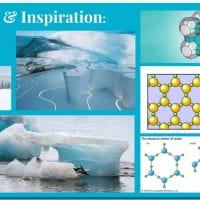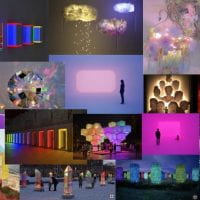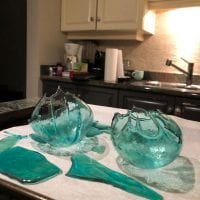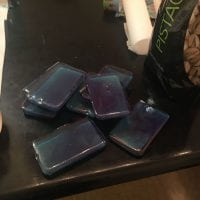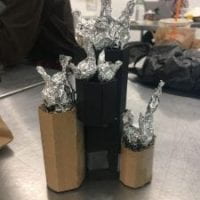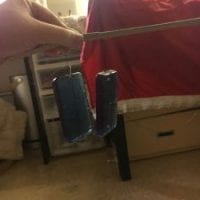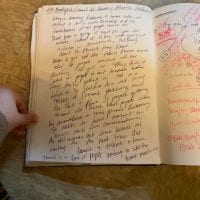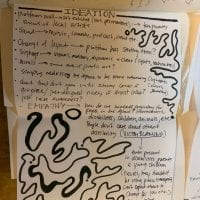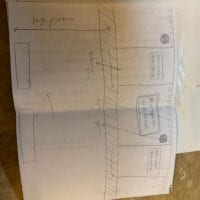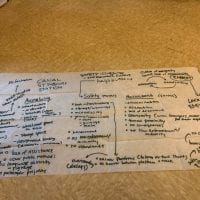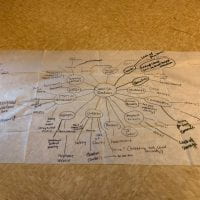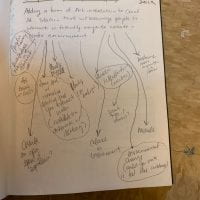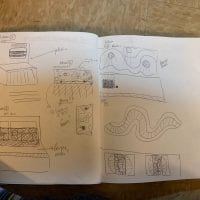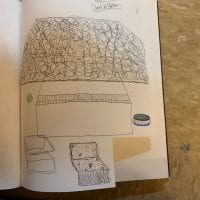Seminar Journal/Bridge 1
Feedback Loops + Poster
I decided to look at the problem of Mass Incarceration in the USA through systems thinking. First I wrote down as many causes and effects of the problem I could think of onto separate pieces of paper. I ended up coming up with 18 different variables.
After this, I looked at all the papers and started to group them into categories I felt were related. I did this a few different times. The main two groups I found were causes directly related to the issue and more broad societal causes/issues that also affected the issue.
Lastly, I took these variables and tried to come up with different feedback loops that affected the problem. Whilst doing this I came up with a couple more points that I added in to complete some of the loops.
Class Activity Documentation/Poster Mass Incarceration
Last Semester Project Research Reflection: Choose a project that you completed last semester. Break down the concepts and research processes used to make the work. Organize your findings using a concept map.
Light Installation: Space/Materiality
We were asked to create a light installation, as a group, with three components that was made partially out of sustainable materials
Ideation:
My group decided to make an installation for children, so we began to do some research on children’s toys and child psychology.
I also did some research about different light installations, chandeliers and sustainable materials I could use.
Created Mood Boards/Maps for inspiration and reference:
I experimented with creating shapes (such as spheres) with sugar. I ended up using sugar as my final material for the project.
Made Prototypes: This helped me figure out what would make the most sense to construct and what physically looked the best.
Audio Walk (Bridge 2) Storyboarding, Research and Planning:
Link to AEIOU worksheet: The commentary is typed into the sheet because I took notes on my phone at the site. AEIOU observation worksheets (1)-1nr737l
Bridge 2:
Audio:
Booklet: Canal St Booklet-r7jybs
Bridge 2 Reflection:
In my Audio Walk of Canal St. Station for the Bridge Two project I focused mostly on research I found about the history of the site along with my own personal observations. Overall, I think it was beneficial to learn about the history of the station, its use as a canal etc, and its construction to gain a better understanding of its current use and to be able to make connections to its past. I think one of the most important parts of the research for this project was also just visiting the site. Canal St. Subway, is quite confusing in its layout and if I hadn’t visited it multiple times I would have found it very confusing to plan my tour. Looking back on the assignment I think I could have visited it one or two more times to ensure that all of my directions and the timing of the audio worked correctly. Unfortunately I also had an issue with listening to the audio on my laptop. This meant that I had to edit the entire project out loud, rather then with headphones. If I were to work on it again, or revise it I would definitely find a way to be able to listen to the audio with headphones, especially considering the fact that that is how it is meant to be listened too. I think it also could’ve helped to listen to the audio piece in the subway, on my intended route, to make sure everything made sense and the audio was clear with the subways background noise.
Canal St Station Intervention Ideas:
Idea 1:
Description: Alienation in the subway often causes a hostile environment where abuse can occur. The one place that alienation is disrupted in the subway is through buskers (ie. music). My intervention on the subway trains would be to have music, comedy, storytelling and other art forms play in the subway. This would cause less people to have headphones in or be distracted by their phones and therefore be more aware of their surroundings. The art played on the existent speaker would be chosen through an online submission portal where they would be reviewed to ensure that they are appropriate for all people riding the subway regardless of age. As well, there would be a specific focus on having the subway play work of local artists and creators who otherwise don’t have the platform to spread their work. There would be no ads.
Audience: The audience for this intervention would be all subway users. This intervention would really be optional for people riding the subway because one could still tune out the sound by using headphones.
Idea 2:
Description: I have always found the platforms of a subway incredibly unsafe, especially when busy, because of the small space and little infrastructure in place to prevent falls. I would intervene by increasing the width of the platform so that there is more space to walk along, without having to walk right beside the edge. Along with this I would add platform screen doors. These are doors that open when the train arrives, so that the tunnel is separated from the platform, thus preventing falls. Another addition besides this could be a system along the walls that includes, visual and auditory signals that the train has arrived. Lights would flash along with an announcement or some sort of sound telling people it is here. This would help the accessibility for people who are blind, death or hard of hearing.
Audience: This intervention is designed to ensure the safety off all subway users. However, it would be of specific assistance to children and people with disabilities.
Bridge 3: Project Proposal
PDF: Project Proposal Studio 2- Hailey Hanson-2jm1pm0
Bridge 3 Reflection:
For Bridge 3 I focused my proposal on attempting to find ways, through a mixture of art and design, to address issues of harassment and safety within the subway station. I stated that I believed some of these issues were created by the anonymity caused by the bad environment in the station. Working on my proposal, I looked at several artists who  worked on installations in the subway. It was really helpful to see what they did to try and create community in that space. Along with that, some of their materials (such as sticky notes) gave me good ideas on how a more temporary project could be created. One that wouldn’t require the same amount of regulation, permission and planning that some larger installations would. I want to continue to find some new artists and inspiration as I work on the piece. I found more images about a European subway system that has art installations throughout all the stations.
worked on installations in the subway. It was really helpful to see what they did to try and create community in that space. Along with that, some of their materials (such as sticky notes) gave me good ideas on how a more temporary project could be created. One that wouldn’t require the same amount of regulation, permission and planning that some larger installations would. I want to continue to find some new artists and inspiration as I work on the piece. I found more images about a European subway system that has art installations throughout all the stations.
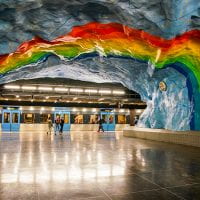 These ones aren’t as interactive, but I think the environmental changes would still have a huge impact on peoples behaviour in the environment. It was also very helpful to get links to other artists in my feedback that I could look at to find even more inspiration for the project.
These ones aren’t as interactive, but I think the environmental changes would still have a huge impact on peoples behaviour in the environment. It was also very helpful to get links to other artists in my feedback that I could look at to find even more inspiration for the project.
Develop three concepts for a creative intervention that builds on the ideas developed in your prototypes:

1. From working on my prototype on the entire space I think it could be interesting to create an art installation environment change. Rather then creating seating or other infrastructure I could just change the environment of the space through an art installation including 3D work on the walls and painting, lights etc.

2. In my prototypes I worked on an idea for a form of seating that would be modern and more beautiful then thecurrent seating. It wouldn’t have arm rests to divide people or create a form of hostile architecture that prevented their use. To continue this I think I could create some other furniture or design changes to make the environment more attractive and functional.

3. Another form of seating that I had worked on was an art installation combined with seating. It wou
ld be a relatively large 3D structure to fill the space, but could also allow a form of seating on the bottom.
Bridge 4: Prototype 1 + Short Critique
Link to Powerpoint:
https://docs.google.com/presentation/d/1HTnc3u6cEWA6zujQqpl8IJlBWRml48r_dxoIQWrFZK8/edit#slide=id.p
Poster:
Reflection: In one page, reflect on the feedback received about for Bridge 4. What does your project communicate? What can be done to strengthen the design? What aspects of the design need to be resolved?
In my project for Bridge 4 I want to create a space that helps make the environment in the subway more positive, whilst also reflecting on the stations history. I want the final project to give the space a calm and tranquil feeling. Along with this I hope it can spark some curiosity within people, and make them interested in looking around the space, rather then at their phone. I think that I need to continue to develop my plan of how I will create the vibe of water within the space. Will I use actual water or just visuals that reflect that feeling? What type of lighting would I include? By making the station into a canal it references the spaces history, but it will also make it feel more natural, contrasting the industrial and harsh environment that it currently has. Nature usually causes people to feel more peaceful and helps reduce anxiety so I think this will be an effective way of creating a positive space. I also want to continue to develop the seating ideas I had. In my critique people had discussed the issue of having homeless people sleeping on benches. My project is supposed to make the environment more positive and welcoming, so I personally don’t think that creating hostile architecture (ie. seating that prevents someone from lying down) reflects the ideals within my project. So I want to continue to work on design ideas for seating that will create a community, strengthen the aesthetic feeling of the space and reflect nature.
Continued Ideation/Sketching:
Studio Canal Street Research Zine
Powerpoint Presentation: https://drive.google.com/open?id=1JNOgN4u_HcvRgfj-Cvz3lcvuG91aDhtUA2sYzQVgRao
Water Video: https://drive.google.com/open?id=1n0bkYSD5re8nQLxXlGaKQGyF4x-kxWoU





